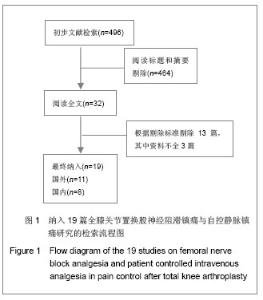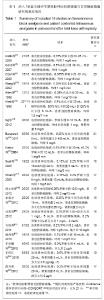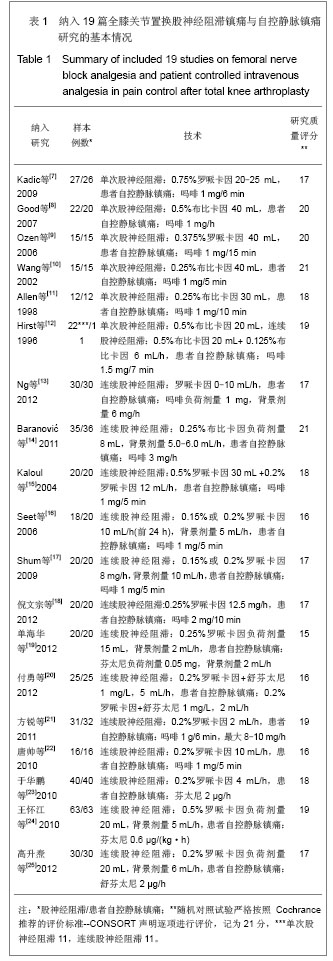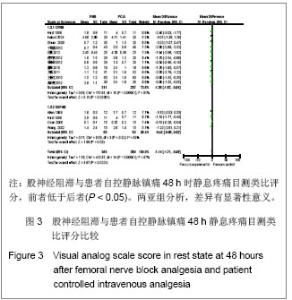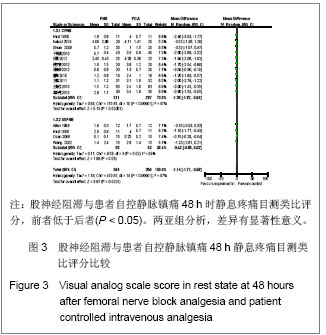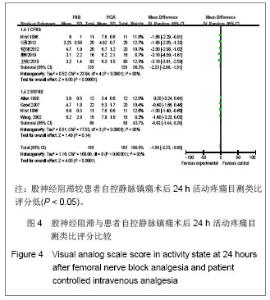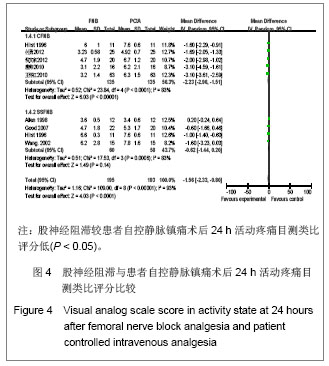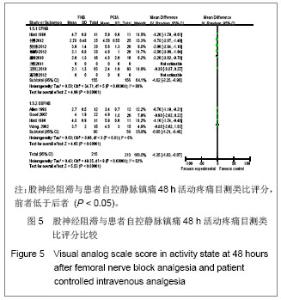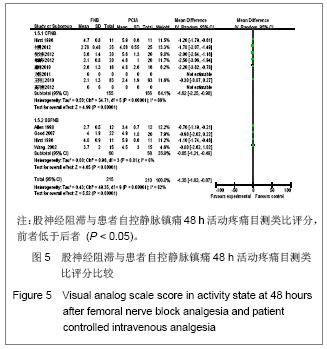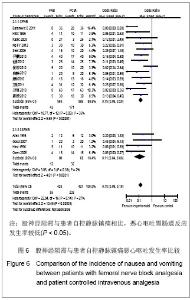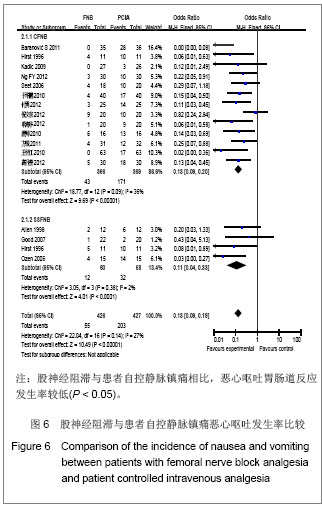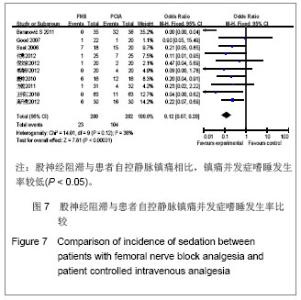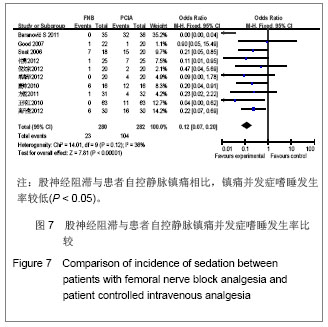Chinese Journal of Tissue Engineering Research ›› 2013, Vol. 17 ›› Issue (17): 3073-3080.doi: 10.3969/j.issn.2095-4344.2013.17.005
Previous Articles Next Articles
Systemic evaluation of femoral nerve block analgesia and patient controlled intravenous analgesia in pain control after total knee arthroplasty
Zhang Qi-dong, Liu Zhao-hui, Cheng Li-ming, Cao San-li, Xu Guang-chun, Lu Yu-feng, Guo Wan-shou
- Department of Joint Surgery, China-Japan Friendship Hospital, Beijing 100029, China
-
Received:2013-01-22Revised:2013-01-30Online:2013-04-23Published:2013-04-23 -
Contact:Guo Wan-shou, Doctor, Chief physician, Department of Joint Surgery, China-Japan Friendship Hospital, Beijing 100029, China -
About author:Zhang Qi-dong☆, Studying for doctorate, Department of Joint Surgery, China-Japan Friendship Hospital, Beijing 100029, China tjzhqd@163.com
CLC Number:
Cite this article
Zhang Qi-dong, Liu Zhao-hui, Cheng Li-ming, Cao San-li, Xu Guang-chun, Lu Yu-feng, . Systemic evaluation of femoral nerve block analgesia and patient controlled intravenous analgesia in pain control after total knee arthroplasty[J]. Chinese Journal of Tissue Engineering Research, 2013, 17(17): 3073-3080.
share this article
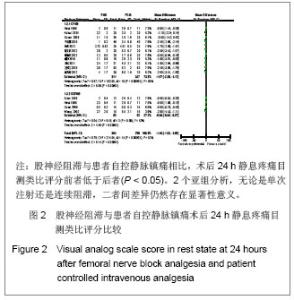
2.2 股神经阻滞与患者自控静脉镇痛术后24 h静息疼痛目测类比评分比较结果 见图2。 对股神经阻滞与患者自控静脉镇痛术后24 h时静息疼痛目测类比评分进行荟萃分析。其中有2个研究采用NRS评分[7, 13],2个研究数据不全[14, 16],未纳入分析。按单次股神经阻滞和连续股神经阻滞两种方式分为2个亚组,各纳入研究11个和4个,2个亚组的各研究间存在异质性,因此采用随机效应模型,合并效应值WMD分别为-1.67和-0.66,P值均小于0.05,说明股神经阻滞与患者自控静脉镇痛相比,无论是采用单次注射还是连续阻滞,术后24 h静息疼痛目测类比评分,前者均优于后者,差异有显著性意义。两亚组合并汇总后进行分析,总的研究例数分别为364膝和350膝,WMD =-1.46,P < 0.05,二者间差异仍然存在显著性意义。"
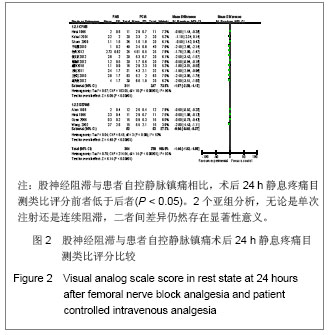
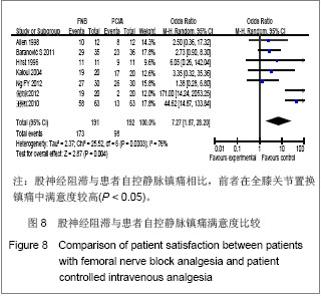
对股神经阻滞与患者自控静脉镇痛并发症嗜睡进行荟萃分析,由于单次股神经阻滞仅有Good等[8]报道,故未作亚组分析,合并效应值OR为0.12,P值小于0.05,说明股神经阻滞与患者自控静脉镇痛相比,镇静并发症嗜睡发生率较低。2组发生率分别为8.2%(23/280)和36.9%(104/282)。 2.8 股神经阻滞与患者自控静脉镇痛满意度比较结果 见图8。 对股神经阻滞与患者自控静脉镇痛并发症嗜睡进行荟萃分析,合并效应值OR为7.27,P值小于0.05,说明股神经阻滞与患者自控静脉镇痛相比,前者在全膝关节置换镇痛中满意度较高,两组满意率分别为90.6% (173/191)和51.0%(98/192)。"
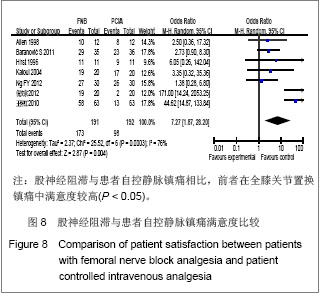
| [1] Choi PT, Bhandari M, Scott J, et al. Epidural analgesia for pain relief following hip or knee replacement. Cochrane Database Syst Rev. 2003;(3):D3071.[2] Lewis C, Gunta K, Mitchell K, et al. Effectiveness of multimodal pain management protocol in total knee arthroplasty patients. Orthop Nurs. 2012;31(3):153-159.[3] Meftah M, Wong AC, Nawabi DH, et al. Pain management after total knee arthroplasty using a multimodal approach. Orthopedics. 2012;35(5):e660-e664.[4] Dalury DF, Lieberman JR, Macdonald SJ. Current and innovative pain management techniques in total knee arthroplasty. Instr Course Lect. 2012;61:383-388.[5] Moher D, Schulz KF, Altman DG, et al. Zhongguo Xunzheng Yixue Zazhi. 2005;5(9):702-707.Moher D,Schulz KF,Altman DG,等. CONSORT声明:提高平行随机试验报告质量的修订建议[J].中国循证医学杂志,2005, 5(9):702-707.[6] Dong BR. Jinggangshan Daxue Xuebao: Ziran Kexueban. 2010;31(1):129-133.董碧蓉. 循证医学与临床实践[J]. 井冈山大学学报: 自然科学版, 2010,31(1):129-133.[7] Kadic L, Boonstra MC, DE Waal MM, et al. Continuous femoral nerve block after total knee arthroplasty. Acta Anaesthesiol Scand. 2009;53(7):914-920.[8] Good RP, Snedden MH, Schieber FC, et al. Effects of a preoperative femoral nerve block on pain management and rehabilitation after total knee arthroplasty. Am J Orthop (Belle Mead NJ). 2007;36(10):554-557.[9] Ozen M, Inan N, Tumer F, et al. The effect of 3-in-1 femoral nerve block with ropivacaine 0.375% on postoperative morphine consumption in elderly patients after total knee replacement surgery. Agri. 2006;18(4):44-50.[10] Wang H, Boctor B, Verner J. The effect of single-injection femoral nerve block on rehabilitation and length of hospital stay after total knee replacement. Reg Anesth Pain Med. 2002;27(2):139-144.[11] Allen HW, Liu SS, Ware PD, et al. Peripheral nerve blocks improve analgesia after total knee replacement surgery. Anesth Analg. 1998;87(1):93-97.[12] Hirst GC, Lang SA, Dust WN, et al. Femoral nerve block. Single injection versus continuous infusion for total knee arthroplasty. Reg Anesth. 1996;21(4):292-297.[13] Ng FY, Chiu KY, Yan CH, et al. Continuous femoral nerve block versus patient-controlled analgesia following total knee arthroplasty. J Orthop Surg (Hong Kong). 2012;20(1): 23-26.[14] Baranovic S, Maldini B, Milosevic M, et al. Peripheral regional analgesia with femoral catheter versus intravenous patient controlled analgesia after total knee arthroplasty: a prospective randomized study. Coll Antropol. 2011;35(4): 1209-1214.[15] Kaloul I, Guay J, Cote C, et al. The posterior lumbar plexus (psoas compartment) block and the three-in-one femoral nerve block provide similar postoperative analgesia after total knee replacement. Can J Anaesth. 2004;51(1):45-51.[16] Seet E, Leong WL, Yeo AS, et al. Effectiveness of 3-in-1 continuous femoral block of differing concentrations compared to patient controlled intravenous morphine for post total knee arthroplasty analgesia and knee rehabilitation. Anaesth Intensive Care. 2006;34(1):25-30.[17] Shum CF, Lo NN, Yeo SJ, et al. Continuous femoral nerve block in total knee arthroplasty: immediate and two-year outcomes. J Arthroplasty. 2009;24(2):204-209.[18] Ni WZ, Li YC, Wang AZ. Shanghai Yixue. 2012;35(4):291-294.倪文宗,李颖川,王爱忠. 超声引导下连续股神经阻滞在全膝关节置换术后镇痛中的应用[J].上海医学,2012,35(4):291-294.[19] Shan HH, Wang WJ, Xie H, et al. Jiangsu Yiyao. 2011;37(18): 2145-2147.单海华,王文娟,谢红,等.超声引导连续股神经阻滞在全膝关节置换术后镇痛中的应用[J].江苏医药,2011,37(18):2145-2147.[20] Fu Y, Han YS. Sichuan Yixue. 2012;33(3):470-473.付勇,韩一生.持续股神经阻滞在全膝关节置换术后功能锻炼中的应用[J]. 四川医学,2012,33(3):470-473.[21] Fang R, Deng YJ, Meng QC, et al. Zhongguo Zuzhi Gongcheng Yanjiu yu Linchuang Kangfu. 2011;15(43): 8027-8030.方锐,邓迎杰,孟庆才,等. 股神经阻滞在全膝人工关节表面置换围手术期多模式镇痛中的应用[J]. 中国组织工程研究与临床康复,2011,15(43):8027-8030.[22] Tang S, Xu ZH, Huang YG, et al. Zhongguo Yixue Kexueyuan Xuebao. 2010;32(5):574-578.唐帅,徐仲煌,黄宇光,等. 连续股神经阻滞和静脉患者自控镇痛对全膝关节置换术围手术期影响的比较[J]. 中国医学科学院学报,2010,32(5):574-578.[23] Yu HP, Liu ZH, GuoWS, et al. Zhongguo Gushang. 2010; 23(11): 825-827.于华鹏,刘朝晖,郭万首,等.连续股神经阻滞在全膝关节置换术后镇痛及早期康复锻炼中的作用[J].中国骨伤,2010,23(11): 825-827.[24] Wang HJ, Zhang DZ, Li SZ. Zhonghua Yixue Zazhi. 2010;90 (33):2360-2362.王怀江,张大志,李世忠. 连续股神经阻滞镇痛与静脉镇痛在全膝关节置换术后镇痛效果的比较[J].中华医学杂志,2010,90(33): 2360-2362. [25] Gao ST, Sun AJ, Zhang P, et al. Zhonghua Guanjie Waike Zazhi: Dianziban. 2012;6(1):36-39.高升焘,孙爱娟,张鹏,等.全膝关节置换术后应用连续股神经阻滞镇痛和静脉自控镇痛的效果比较[J].中华关节外科杂志:电子版, 2012,6(1):36-39.[26] Dalury DF, Lieberman JR, Macdonald SJ. Current and innovative pain management techniques in total knee arthroplasty. J Bone Joint Surg Am. 2011;93(20):1938-1943.[27] Krych AJ, Horlocker TT, Hebl JR, et al. Contemporary pain management strategies for minimally invasive total knee arthroplasty. Instr Course Lect. 2010;59:99-109.[28] Ranawat AS, Ranawat CS. Pain management and accelerated rehabilitation for total hip and total knee arthroplasty. J Arthroplasty. 2007;22(7 Suppl 3):12-15.[29] Liu GJ, Wu TX, Kang DY. Zhongguo Linchuang Kangfu. 2003; 7(4):538-539.刘关键,吴泰相,康德英. Meta-分析中的统计学过程[J].中国临床康复,2003,7(4):538-539.[30] Asakura Y, Tsuchiya H, Mori H, et al. Reduction of the incidence of development of venous thromboembolism by ultrasound-guided femoral nerve block in total knee arthroplasty. Korean J Anesthesiol. 2011;61(5):382-387.[31] Wang AZ, Gu L, Zhou QH, et al. Ultrasound-guided continuous femoral nerve block for analgesia after total knee arthroplasty: catheter perpendicular to the nerve versus catheter parallel to the nerve. Reg Anesth Pain Med. 2010; 35(2):127-131.[32] Hunt KJ, Bourne MH, Mariani EM. Single-injection femoral and sciatic nerve blocks for pain control after total knee arthroplasty. J Arthroplasty. 2009;24(4):533-538.[33] Singelyn FJ, Deyaert M, Joris D, et al. Effects of intravenous patient-controlled analgesia with morphine, continuous epidural analgesia, and continuous three-in-one block on postoperative pain and knee rehabilitation after unilateral total knee arthroplasty. Anesth Analg. 1998;87(1):88-92.[34] Ganapathy S, Wasserman RA, Watson JT, et al. Modified continuous femoral three-in-one block for postoperative pain after total knee arthroplasty. Anesth Analg. 1999;89(5): 1197-1202.[35] Mistraletti G, De La Cuadra-Fontaine JC, Asenjo FJ, et al. Comparison of analgesic methods for total knee arthroplasty: metabolic effect of exogenous glucose. Reg Anesth Pain Med. 2006;31(3):260-269.[36] Widmer BJ, Scholes CJ, Pattullo GG, et al. Is femoral nerve block necessary during total knee arthroplasty: a randomized controlled trial. J Arthroplasty. 2012;27(10):1800-1805.[37] Sharma S, Iorio R, Specht LM, et al. Complications of femoral nerve block for total knee arthroplasty. Clin Orthop Relat Res. 2010;468(1):135-140. |
| [1] | Wang Jinjun, Deng Zengfa, Liu Kang, He Zhiyong, Yu Xinping, Liang Jianji, Li Chen, Guo Zhouyang. Hemostatic effect and safety of intravenous drip of tranexamic acid combined with topical application of cocktail containing tranexamic acid in total knee arthroplasty [J]. Chinese Journal of Tissue Engineering Research, 2021, 25(9): 1356-1361. |
| [2] | Zhou Jihui, Li Xinzhi, Zhou You, Huang Wei, Chen Wenyao. Multiple problems in the selection of implants for patellar fracture [J]. Chinese Journal of Tissue Engineering Research, 2021, 25(9): 1440-1445. |
| [3] | Chen Junming, Yue Chen, He Peilin, Zhang Juntao, Sun Moyuan, Liu Youwen. Hip arthroplasty versus proximal femoral nail antirotation for intertrochanteric fractures in older adults: a meta-analysis [J]. Chinese Journal of Tissue Engineering Research, 2021, 25(9): 1452-1457. |
| [4] | Chen Jinping, Li Kui, Chen Qian, Guo Haoran, Zhang Yingbo, Wei Peng. Meta-analysis of the efficacy and safety of tranexamic acid in open spinal surgery [J]. Chinese Journal of Tissue Engineering Research, 2021, 25(9): 1458-1464. |
| [5] | Hu Kai, Qiao Xiaohong, Zhang Yonghong, Wang Dong, Qin Sihe. Treatment of displaced intra-articular calcaneal fractures with cannulated screws and plates: a meta-analysis of 15 randomized controlled trials [J]. Chinese Journal of Tissue Engineering Research, 2021, 25(9): 1465-1470. |
| [6] | Huang Dengcheng, Wang Zhike, Cao Xuewei. Comparison of the short-term efficacy of extracorporeal shock wave therapy for middle-aged and elderly knee osteoarthritis: a meta-analysis [J]. Chinese Journal of Tissue Engineering Research, 2021, 25(9): 1471-1476. |
| [7] | Wang Yongsheng, Wu Yang, Li Yanchun. Effect of acute high-intensity exercise on appetite hormones in adults: a meta-analysis [J]. Chinese Journal of Tissue Engineering Research, 2021, 25(8): 1305-1312. |
| [8] | Kong Desheng, He Jingjing, Feng Baofeng, Guo Ruiyun, Asiamah Ernest Amponsah, Lü Fei, Zhang Shuhan, Zhang Xiaolin, Ma Jun, Cui Huixian. Efficacy of mesenchymal stem cells in the spinal cord injury of large animal models: a meta-analysis [J]. Chinese Journal of Tissue Engineering Research, 2021, 25(7): 1142-1148. |
| [9] | Huang Dengcheng, Wang Zhike, Cao Xuewei. Intravenous, topical tranexamic acid alone or their combination in total knee arthroplasty: a meta-analysis of randomized controlled trials [J]. Chinese Journal of Tissue Engineering Research, 2021, 25(6): 948-956. |
| [10] | Li Yan, Wang Pei, Deng Donghuan, Yan Wei, Li Lei, Jiang Hongjiang. Electroacupuncture for pain control after total knee arthroplasty: a meta-analysis [J]. Chinese Journal of Tissue Engineering Research, 2021, 25(6): 957-963. |
| [11] | He Xiangzhong, Chen Haiyun, Liu Jun, Lü Yang, Pan Jianke, Yang Wenbin, He Jingwen, Huang Junhan. Platelet-rich plasma combined with microfracture versus microfracture in the treatment of knee cartilage lesions: a meta-analysis [J]. Chinese Journal of Tissue Engineering Research, 2021, 25(6): 964-969. |
| [12] | Hua Haotian, Zhao Wenyu, Zhang Lei, Bai Wenbo, Wang Xinwei. Meta-analysis of clinical efficacy and safety of antibiotic artificial bone in the treatment of chronic osteomyelitis [J]. Chinese Journal of Tissue Engineering Research, 2021, 25(6): 970-976. |
| [13] | Zhan Fangbiao, Cheng Jun, Zou Xinsen, Long Jie, Xie Lizhong, Deng Qianrong. Intraoperative intravenous application of tranexamic acid reduces perioperative bleeding in multilevel posterior spinal surgery: a meta-analysis [J]. Chinese Journal of Tissue Engineering Research, 2021, 25(6): 977-984. |
| [14] | Zhao Zhongyi, Li Yongzhen, Chen Feng, Ji Aiyu. Comparison of total knee arthroplasty and unicompartmental knee arthroplasty in treatment of traumatic osteoarthritis [J]. Chinese Journal of Tissue Engineering Research, 2021, 25(6): 854-859. |
| [15] | Zhang Nianjun, Chen Ru. Analgesic effect of cocktail therapy combined with femoral nerve block on total knee arthroplasty [J]. Chinese Journal of Tissue Engineering Research, 2021, 25(6): 866-872. |
| Viewed | ||||||
|
Full text |
|
|||||
|
Abstract |
|
|||||
